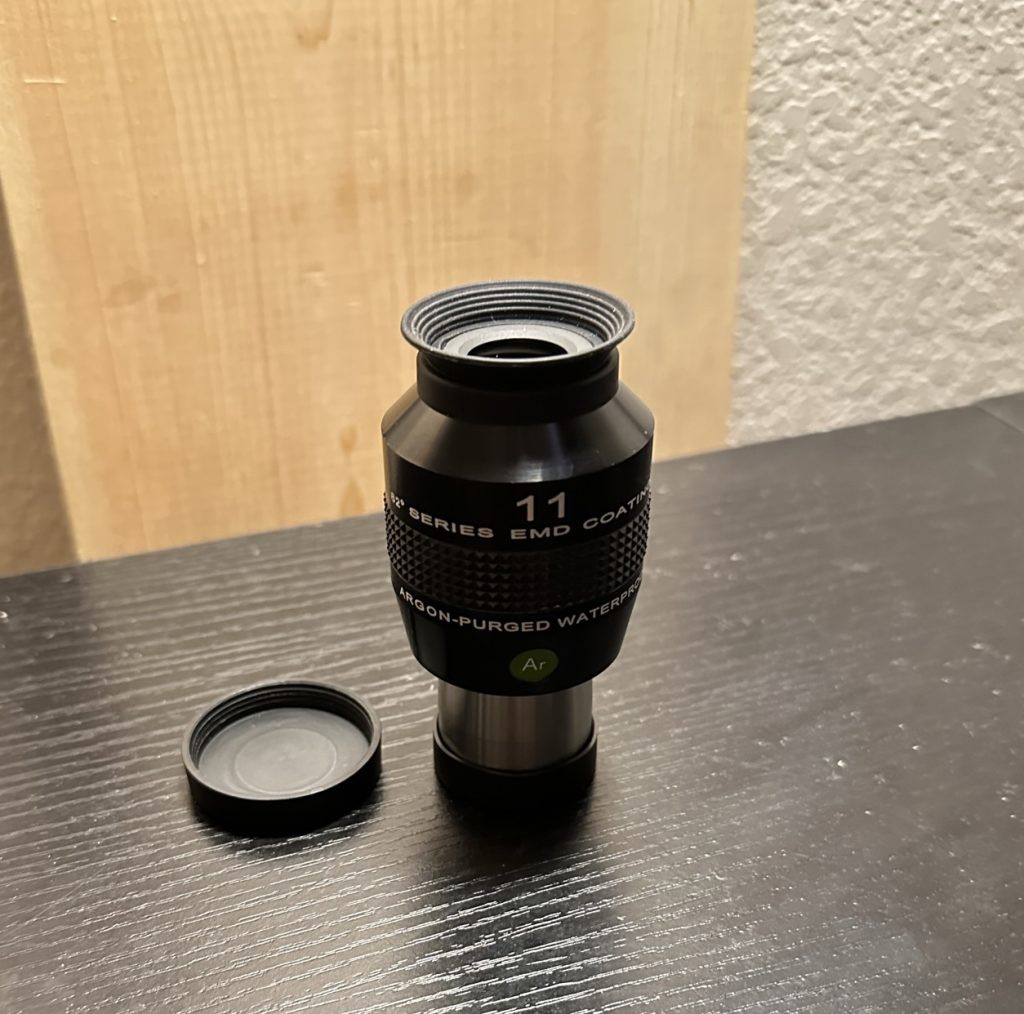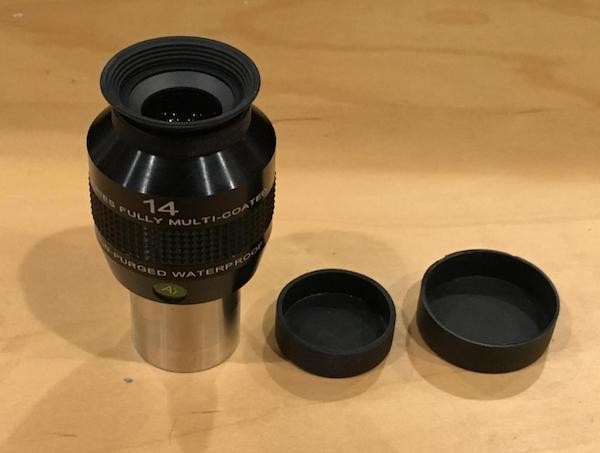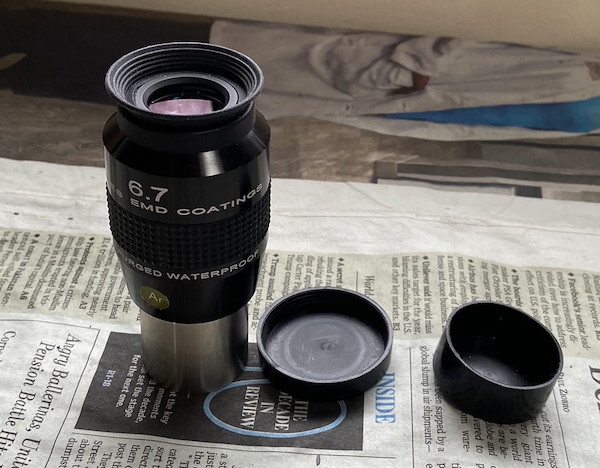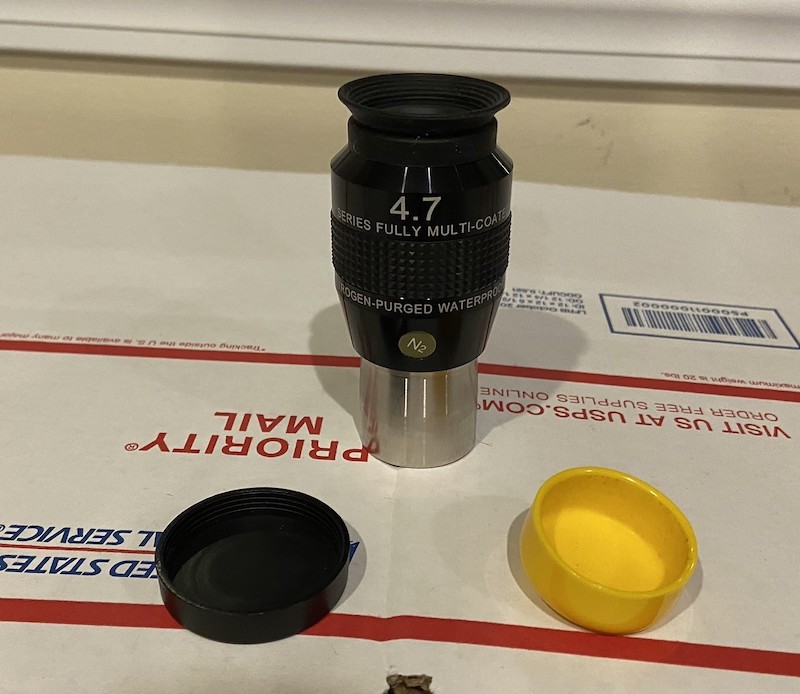This review is about my firsthand experience with the Explore Scientific 8.8 mm and 6.7 mm 82º eyepieces. I will outline why I purchased them and discuss the calculations used to determine magnification and field of view. Most of my comments about the 8.8 mm and 6.7 mm ES 82ºs also apply to the other focal length ES 82ºs available.



The ES 82º is a wide view eyepiece. They offer an 82º apparent field of view, hence the name. While there are no standards on what constitutes “wide,” the industry seems to consider “wide” to be anything bigger than the 45º–55º apparent field of view (AFOV) of most Plossl, Kellner, and other cheap eyepiece designs commonly sold with beginner telescopes.
Eyepieces with a 60º field of view are considered wide. Eyepieces wider than 68º are considered super wide. Eyepieces wider than an 80º are ultra wide. Note that there are eyepieces that go all the way to a 120º apparent field of view.
Thus, the ES 82º eyepiece would be considered an ultra wide eyepiece. Use whatever term you like, but these are nice eyepieces.
The Wider True Field of View
Using the following simplified formulas, we can estimate the true field of view the eyepiece will provide in any given telescope.
Focal Length of Scope / Focal Length of Eyepiece = Magnification
Apparent Field of View (AFOV) Eyepiece / Magnification = True Field of View
Using my Orion XT8i with 1200 mm of focal length as an example:
- An 8.8 mm Plossl eyepiece with a 52º field of view would produce 136X and a 0.38 degree true field of view. This is a little less than the width of the full moon, which is about 0.5º.
- The 8.8 mm ES 82º eyepiece produces the same 136X, but I would have a 0.6º field of view, or wider than a full moon.
- The 6.7 mm ES 82º produces 179X with a true field of view of about 0.46º. If I used a same focal length cheaper Plossl of 52º AFOV, the true field of view would be a tight 0.29º.
The wider field of view offers me three benefits.
- When using a manual scope, I have more drift time for the target to remain in view.
- I can see more when viewing larger targets, such as the Andromeda Galaxy, which is over 3º wide.
- I can see smaller targets in the context of their surroundings—what some people call a “more immersive visual experience.”
So, are ES 82ºs worth it? I’d say, yes!
Better Corrected For Use in Lower Focal Ratio Scopes
There are cheaper alternatives to Explore Scientific 82º, and I have tried a few. Unfortunately, when using shorter focal ratio telescopes, say, less than f/7, cheap wide-field eyepieces will usually show significant distortion or aberration as your view approaches the field of view’s edge.
But with the Explore Scientific 82º eyepiece, using my f/5 Meade ETX-80 and f/5.9 Orion XT8i scopes, the image was clean, crisp, and sharp. I had been using Plossls that came with both scopes before buying the ES 82º. Plossls offer fairly sharp images for their price, but their apparent field of view is only 52º. I was interested in a wider field-of-view eyepiece, especially for my manually tracked XT8i.
I have also used these in my f/15 Meade ETX-125, which is a Maksutov-Cassegrain design, and the image is excellent. The wide field really works well with this scope and is highly recommended for high focal ratio scopes, too.
Provides More Eye Relief, Making Them More Comfortable To Use
Another benefit of these eyepieces, compared to Plossl eyepieces and many other eyepiece designs, is eye relief. This is the distance you should keep your eye from the lens in order to see the entire field of view.
A typical 9 mm Plossl eyepiece has about 6 mm of eye relief. That would mean your eye would have to be almost touching the lens in order to see the full field of view. Compare this to the 15.6 mm of eye relief the ES 82º 8.8 has, and you will see why the ES 82º is much more comfortable to use.
A 6 mm Plossl has a super short 5 mm of eye relief as compared to the 15.7 mm of eye relief for the ES 6.7 82º eyepiece. And of course, that full field of view is much smaller in the Plossl.
If you use glasses, eye relief is critical. You can’t get your eye within 5 mm of the top lens of an eyepiece with glasses on. You need that extra eye relief in order to see the field of view.
I wear glasses, but not when I observe. I find it very comfortable to use with 15.6 mm and 15.7 mm of eye relief without my glasses. However, I have tested these reliefs with my glasses as well, and I am still able to see the full field of view.
Features I’d Like You To Notice
- The ES 82º eyepieces are waterproof and purged with argon gas.
Argon gas prevents moisture from intruding into the eyepiece, which could produce fogging or the internal growth of mold and fungus. Older eyepieces were nitrogen-purged; nitrogen purging was less effective as the nitrogen molecules are smaller and thus more prone to leaking from the eyepiece.
While there is no reason to have eyepieces out in the rain, if you are at a location where there is heavy dew, a waterproof eyepiece is a good idea.
What I’m going to say might surprise you, but this also simplifies cleaning. Explore Scientific recommends simply dunking their eyepieces in a bowl of distilled water with some dish soap added to clean them.
- The ES 82ºs are fully multi coated with Explore Scientific’s EMD (Enhanced Multilayer Dispersion) coatings.
Explore Scientific does not provide precise information on its website concerning what their eyepieces are made out of. However, other sources report that these eyepieces contain seven elements, including crown, flint, and lanthanum glass.
- The eyepieces have an eyecup, which helps you position your eye properly on the eyepiece.

This can also help block stray light, which is helpful for me at my light-polluted home location.
- The ES eyepiece comes with a one-year warranty, but read on.
However, each eyepiece has a laser-etched serial number. If you register your eyepiece through ES using this serial number within sixty days of purchase, they will convert your warranty into an Explore Star extended life warranty—a lifetime, transferable warranty that covers all accidents or damages. Clearly, they have a lot of confidence in their product.
Eyepieces’ Sample Specifications
Provided below are the specifications of the 8.8mm and 6.7mm eyepieces that I’ve personally used:
| Feature | 8.8 mm Eyepiece | 6.7 mm Eyepiece |
|---|---|---|
| Length | 85 mm | 90 mm |
| Width | 48 mm | 43 mm |
| Weight | 8.9 oz; 255 g | 8.0 oz; 228 g |
| Barrel Size | 1.25″ | 1.25″ |
| Eye Relief | 15.6 mm | 15.7 mm |
| Field Stop Diameter | 12.4 mm | 9.5 mm |

Since writing the review of the Explore Scientific 82 degree 6.7 mm and 8.8 mm I have added the ES 82 14 mm and 4.7 mm eyepieces to my eyepiece set. They are excellent. I use them in 6 different telescopes including two 80 mm F5 refractors, a 100 mm F4 Newtonian, a 127 mm F15 Mak, a 305 mm Dobsonian/Newtonian, and a 350 mm F10 SCT. They perform well in all of them.
Hello Ed! Out of the bunch, for planetary viewing with a telescope similar to your Orion 8 inch scope, which one of the ES eyepieces would you say it performs the best in avergae- good seeing conditions? Thanks in advance for your reply and for you reviews, they are very helpful especially for people who just started with this hobby!
It is all a matter of atmospheric conditions. In the 8″ I found I topped out around 200x on planets quite often. But some nights I could go to 300x. So you want a range of options a the opportunity to test to see what works best that night.
Hello there Ed ! Thank you very much for your reviews , I’ve read them and they were extremely helpful. I do have at the moment a Skywatcher 203/1200 5.9 f/ that I am using and I am considering to purchase an ES 82 degrees 4.7mm eyepiece. Would that be a good purchase considering and will it give me a nice magnification while not losing too much on sharp/contrast when viewing the planets or do you suggest something else ? (asking of course under good seeing conditions )
That eyepiece is a good choice for your scope but you will need good seeing conditions to use that magnification. I used the 4.7 in my 8″ Dob.
Hi Ed,
Thanks for the review. I was gifted an older Bushnell reflector and I was hooked. I am a newbie but I wanted an upgrade that expanded my options without breaking the bank. I chose to get an Explore Scientific First Light 8″ Dobsonian. It comes with a 25 mm by 52 eyepiece, but I also ordered an 11 mm by 82. My question is do you think that I should replace the included 25mm and upgrade it to the 82 degree? There is a lot to unpack when it comes to understanding eyepieces and I am hesitant to shell out $200 bucks to replace something that I already have. Thanks for your time and thoughts.
Tom
An 8″ Dob is a wonderful scope. You will be able to see a lot. I had an 8″ but have upgraded to a 12″. I keep them in the garage and move the scope with a hand truck so I don’t have to carry it around. Works great!
As for the included 25 mm, it sounds like it is a Plossl which is often a good eyepiece but it does not have a wide field of view like the ES 82s. I would use it for a while, then consider an upgrade. That scope probably has a 2″ focuser so I would suggest you consider one or two low power wide view 2″ eyepieces. I have a 2″ 38 mm /70 degree and a 2″ 20 mm 82 degree for my Dob.
The ES 82s are wonderful but the ES 68s are an excellent choice if the ES 82s are a bit too expensive for you. And remember that you don’t have to get the same brand of eyepieces as the scope.
Choosing Eyepieces is a complex topic. This article may help you better understand them, and I include recommendations by price point.
https://telescopicwatch.com/best-telescope-eyepieces/
Enjoy the sky!
“I wear glasses, but not when I observe. I find it very comfortable to use with 15.6 mm and 15.7 mm of eye relief without my glasses. However, I have tested these reliefs with my glasses as well, and I am still able to see the full field of view.”
The above statements seem odd considering nearly all other reviewers say you you need to push your eye down into the rubber eye guard to see the whole field. Are you sure you were actually seeing the whole field? Typically when I’m using mine (without glasses) I’m not seeing the edges when my eye is in a comfortable position.